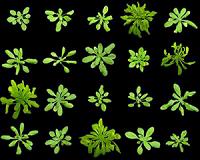| . |  |
. |
Gothenburg, Sweden (SPX) Jan 07, 2010 Every year, large amounts of hatchery-raised young salmonids are released into Swedish rivers and streams to compensate for losses in natural production. Butthese fish generally survive poorly in the wild.. Researchers at the University of Gothenburg have discovered why: the young fish get too crowded at the hatchery. The Swedish Research Council Formas is now granting 20 million SEK to a Swedish/Nordic research project. The goal is to find out how the hatcheries can be made more effective.
Raised fish face problems
Increased survival
Millions to salmon research
Natural hatching
Sustainable practices
Share This Article With Planet Earth
Related Links University of Gothenburg Darwin Today At TerraDaily.com
 Evolution Caught In The Act
Evolution Caught In The ActMunich, Germany (SPX) Jan 06, 2010 Mutations are the raw material of evolution. Charles Darwin already recognized that evolution depends on heritable differences between individuals: those who are better adapted to the environment have better chances to pass on their genes to the next generation. A species can only evolve if the genome changes through new mutations, with the best new variants surviving the sieve of selection. ... read more |
|
| The content herein, unless otherwise known to be public domain, are Copyright 1995-2009 - SpaceDaily. AFP and UPI Wire Stories are copyright Agence France-Presse and United Press International. ESA Portal Reports are copyright European Space Agency. All NASA sourced material is public domain. Additional copyrights may apply in whole or part to other bona fide parties. Advertising does not imply endorsement,agreement or approval of any opinions, statements or information provided by SpaceDaily on any Web page published or hosted by SpaceDaily. Privacy Statement |